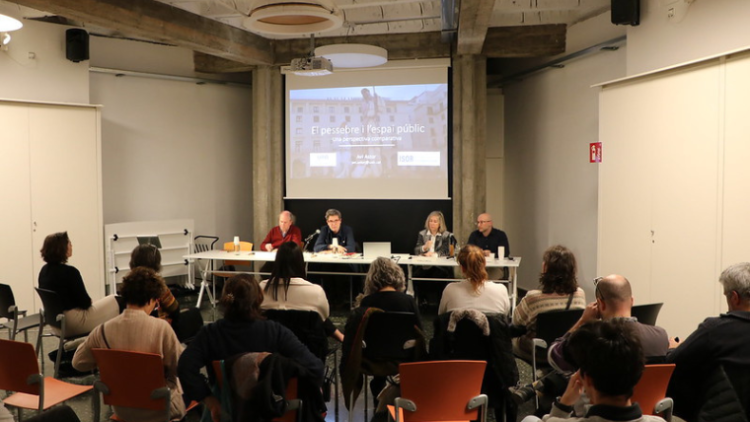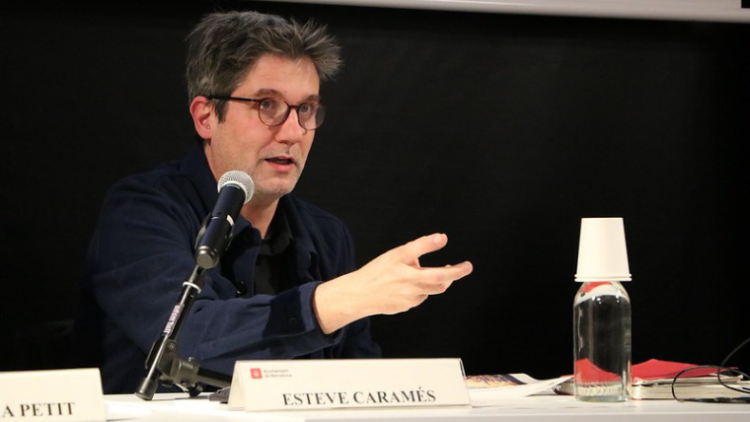CHRISTIANITY | “In Barcelona, the multidimensional nature of the nativity scene allows for adaptation and the promotion of the principles of pluralism, inclusion and neutrality”, Avi Astor
The conference, “Nativity scenes in Barcelona: cultural and religious heritage in public space”, organised by the Religious Affairs office in collaboration with the Museu Etnològic i de Cultures del Món (MUEC), took place on 21 December as part of the celebration of 800 years of the nativity scene tradition. It took the form of a conference in which participants reflected on the cultural and religious symbology of this tradition and was followed by a guided tour of the permanent exhibition of nativity scenes in the MUEC.
In 1223, St. Francis of Assisi created a representation of the birth of Jesus in a cave in Greccio, Italy. 800 years later, Barcelona City Council, as a member of the Catalan organising committee of 800 years of the Nativity Scene, has organised various activities in the city to commemorate this anniversary. As part of this commemoration, on Thursday 21 December, the Montjuïc park venue of the Museu Etnològic de Cultures del Món (MUEC) hosted an event entitled “Nativity scenes in Barcelona, cultural and religious heritage in public space”, organised by the Religious Affairs Office (OAR) in collaboration with the MUEC.
The event took the form of a conference in which participants reflected on the nativity scene as a religious practice in a secular society and the alternatives that have opened up and continue to open up with regard to adapting it to new contexts in public space. Lluís Garcia Petit, managing director of the ‘Institute for Intangible Cultural Heritage (IPACIM), moderated the three presentations and the subsequent debate. There were interventions from Avi Astor, sociologist and member of the Sociology of Religion research group at the UAB; Núria Garcia Múrcia, member of the Catalan Federation of Nativity Scene Builders; and Esteve Caramés, director of Cultural Programmes at the Barcelona Institute of Culture (ICUB). Also, in the preparations for the conference, advice was sought from Enric Benavent, anthropologist and researcher who is an expert on religious symbolism in public space and nativity-scene building in Catalonia.
The conference opened with a few words from the Commissioner for Citizen Relations and Cultural and Religious Diversity at Barcelona City Council, Sara Belbeida. She underscored the importance of the nativity scene in Barcelona, where, over the festive period, numerous nativity scenes have been on display offering diverse representations of this cultural manifestation, thereby demonstrating “the diversity of nativity scenes in every sense, which is Barcelona itself, diversity in every sense. And the nativity scene in Barcelona is religion, culture, creativity, tradition, associationism, plurality, values and many other things”.
Following this, Lluís Garcia gave the floor to the various speakers. Esteve Caramés, following the line taken by Sara Belbeida, defined the nativity scene as a significant part of Barcelona’s festive season: “Christmas can not be understood without the nativity scene, as an integral and traditional element”. But also as an “approach closely tied to the reality of the city”. This means that it not only feeds on the tradition on which this festival is based, but that there needs to be an interpretation of this tradition itself which is linked to the reality of the city of Barcelona”. It is a question of “translating the cultural reality of the city into a festive programme and doing so in a twofold way. On the one hand, with the more classic tradition of nativity-scene building with representations like those by the Barcelona Association of Nativity Scene Builders in the Museu Frederic Marès, and at the same time, with exhibitions that feed on Barcelona’s cultural wealth, making use of its street arts, illustration, scenography or photography. “Tradition doesn’t dictate how we do nativity scenes, simply that we do nativity scenes’. What is important is that citizens take part”, continued the director of cultural programmes at the ICUB. By way of an example, she talked about the nativity scene in Plaça Sant Jaume, which, year after year, is installed by the ICUB and “when it causes controversy, it helps to bring the city to life, because all cultural traditions are dynamic”.
Núria Garcia, founding member of the Catalan Association of Nativity Scene Builders, then took the floor and offered a review of different issues related to nativity-scene building, its history and popularity in the city. She described the act of making a nativity scene as “an artistic and cultural manifestation, preferably located in public space, which is multifaceted but which aims to create a dialogue with the observer and which is also an ephemeral object”. Within this framework, she explained, there are three types of nativity scene: the traditional or popular scene which is found in people’s homes; the artistic scene or diorama, which first appeared in Barcelona in 1912, courtesy of Antoni Moliné, and new formats and languages. Núria Garcia also highlighted the importance of the nativity-scene builders association movement, which began in 1864 with the creation of the Barcelona Association of Nativity Scene Builders. Finally, she concluded with a reflection on the link between the nativity scene and its religious origins and the future prospects of the practice: “Religion is the origin of the nativity scene, but religion will not save the nativity scene: it will be saved by people practising the tradition in a cross-cutting way. Because you don’t need to be Catholic. The nativity scene is part of Catalan custom, of our tradition”.
The third and final presentation was given by Avi Astor, who gave a talk entitled “The nativity scene and public space: a comparative perspective”. In it he contrasted the different approaches in the United States and Barcelona to the public installation of nativity scenes. In the United States, since the 1970s, the nativity scene in public space has been the object of debate and litigation insofar as it is a battleground in the debate on the separation of Church and State. In the legal arena, one of the solutions entails understanding “government spaces as public forums where anyone can freely express themselves”. So nowadays, almost all capitols in the United States display a nativity scene, which has in turn led to responses from secular and atheist sectors of the population. For their part, these population sectors have started to set up non-conformist nativity scenes demanding greater pluralism and secularity in the public presence of what they see as religious elements, to the point that “public spaces of government have become places of dispute for and against religion”. In contrast, Barcelona has taken a different route which entails following an adaptive model: “The complexity and multidimensional nature of the nativity scene allows for many possibilities in terms of creative adaptation and therefore, reflecting and promoting the principles of pluralism, inclusion and neutrality”.
The question of the link between religion and nativity scenes which Avi Astor put on the table was the starting point for a brief exchange between the speakers and the audience in which Esteve Caramés underscored the capacity of nativity scenes to raise questions of this nature: “The secular nature of the nativity scene is not a key question in the debate in Catalonia, but I do think it is important to reflect on it”. In contrast, for Núria Garcia, the religious nature of the nativity scene and nativity scene building is a secondary issue: “I think that many nativity-scene builders, if we were to think about the religious nature of the nativity scene, would stop doing it. The fact is that it is a very broad field that everyone can identify with, and which goes beyond any particular belief”. These views also led to a number of interventions from the audience. The first member of the audience to speak pointed out that Catalan culture has undeniable Catholic roots: in La Patum (a traditional festival) there are angels, in the fire runs, we have demons, in Barcelona we celebrate Santa Eulàlia… And we never question the religious nature of these festivals, we don’t link them to religion. It is curious that this is not the case with nativity scenes”.
In some ways, this questioning is precisely what enables a discussion to be had on adapting traditions like nativity-scene building to new contexts. With regard to this matter, Esteve Caramés pressed home the importance of thinking about the secular nature of the custom: “We can not overlook the fact that all cultural traditions come from spirituality. I think we need to consider this, bring it to the debate, reflect on it and reach a consensus and here introduce into the debate the traditions of minority communities”. Along the same lines, another member of the audience made the following point: “Maybe it makes sense to reinforce other representations, in festivals, whether or not they are religious, other world views, thinking about popular culture in a broader sense, moving beyond the Catalan tradition”. A third member of the audience backed up this point, underscoring the fact that: “We are not a secular state, we are a non-denominational state. We have a plural model, so I don’t see the need to adapt as such. Let’s allow Barcelona to be inundated with Christian symbols at Christmas time and do the same on dates marked by other communities and religions”. It should be said that for years now, Plaça Sant Jaume has been the scene of religious and spiritual manifestations of other traditions. The most prominent of these would be the celebration of Hanukkah. However, it is true that often they are still far from attracting the crowds that elements linked to celebrations from the Catholic calendar attract, like the nativity scenes.
The conference was followed by a guided tour of the permanent exhibition of nativity scenes at the MUEC, led by Lluís Ramoneda, head of the museum’s Department of Collections. The tour began at a display case in the lobby dedicated to Andean nativity scenes, which highlighted cultural adaptation in the opposite direction to that discussed in the conference: “The arrival of Christianity in Peru meant adapting Andean techniques and traditions to the Christian calendar and practices. So, for example, we have the Three Wise Men far from their nativity scenes”, explained Lluís Ramoneda. Afterwards they moved on to the exhibition room and to the visible reserve collection, a storage space which is open to the public where you can see a diverse range of objects displayed in a total of 46 cases. Seven of these display cases hold a large quantity of nativity scene figures and a number of moulds. A further four are dedicated to designer nativity scenes, and another three to popular nativity scenes from Portugal, Murcia, Germany, Provence, Guatemala, Mexico, Peru, Catalonia and Mallorca. The majority of these pieces were collected on expeditions where the Museum picked up not only everyday artefacts, but also craft items. All of them, concluded Lluís Ramoneda, “show the link between this practice and everyday life”.







